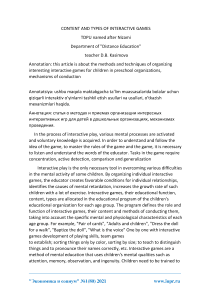Content and types of interactive games
Автор: Kasimova D.B.
Журнал: Экономика и социум @ekonomika-socium
Рубрика: Основной раздел
Статья в выпуске: 1-1 (80), 2021 года.
Бесплатный доступ
This article is about the methods and techniques of organizing interesting interactive games for children in preschool organizations, mechanisms of conduction
Короткий адрес: https://sciup.org/140258268
IDR: 140258268 | УДК: 001
Текст научной статьи Content and types of interactive games
In the process of interactive play, various mental processes are activated and voluntary knowledge is acquired. In order to understand and follow the idea of the game, to master the rules of the game and the game, it is necessary to listen and understand the words of the educator. Tasks in the game require concentration, active detection, comparison and generalization
Interactive play is the only necessary tool in overcoming various difficulties in the mental activity of some children. By organizing individual interactive games, the educator creates favorable conditions for individual relationships, identifies the causes of mental retardation, increases the growth rate of such children with a lot of exercise. Interactive games, their educational function, content, types are allocated in the educational program of the children's educational organization for each age group. The program defines the role and function of interactive games, their content and methods of conducting them, taking into account the specific mental and physiological characteristics of each age group. For example, "Pair of cards", "Adults and children", "Dress the doll for a walk", "Baptize the doll", "What is the voice" One by one with interactive games development of playing skills, team games to establish; sorting things only by color, sorting by size; to teach to distinguish things and to pronounce their names correctly, etc. Interactive games are a method of mental education that uses children's mental qualities such as attention, memory, observation, and ingenuity. Children need to be trained to do this in order to be educated, to develop skills and competencies. Exercise is a necessary element of education. Exercises in the form of games are perceived differently by children: they repeat the necessary words and actions with effort, interest and even satisfaction Interactive games are an important way to enhance and activate vocabulary. The educator needs to think about the actions of the game, that is, what the children do in the game. The rules of the game that children need to follow need to be thought out and articulated in advance. For example, in the “Wonderful Bag” game, the educator says, “Despite the bag, we put our hand in it, feel it, find out what's in it, and say its name. . . You say the name of the toy and show it. For example, in the preschool groups, the game "Travel" can be described as follows:
“When we walk around the city, we meet a lot of people - pedestrians, vehicles, various buildings, decorations. We still travel around the city, but these cities are in the pictures. First we select two groups of children (or 2 children). A group of children look at what vehicles are in the city in the photo. He collects a picture of the vehicles in the city. Another group of children looks at what buildings are in the city. Hurry up! We'll see who finishes the journey faster. "
What games can be used for dictionary work?
Interactive games in small groups focus on the vocabulary of life, that is, the words that describe the names, qualities, and functions of the objects around the children.
The task of interactive games and exercises is for the manager to choose the answer clearly and quickly. These exercises are short (5-10 minutes) and are part of the native language course. In the beginning, the exercises are slower, with the educator correcting the children's answers, using the correct wording method, or making extensive use of it. You can use a ball or a handkerchief in such games. The manager throws the ball to one of the players and asks (for example, in a quality match): "How's the apple?" The boy holding the ball, throwing it back, replies, "Cooked." The manager grabs the ball, throws it to the other child, and asks the same question. Now he needs to find another answer: “Red” and green and so on. There are many types of oral exercises.
Riddles are widely used in the education of preschool children. The content of the puzzle is the reality of the children's environment: natural phenomena, labor processes, objects, plants, animals and man himself.
When using puzzles when working with children, their educational and pedagogical value should be taken into account.
Riddles are open and secret questions. For example, educators ask children, "What is the name of an animal that has long ears, soft fur, runs fast, and loves carrots?" he asks.
Play is one of the most effective means of education for preschool children. In the process of interactive play, a certain relationship is established between the children, that is, a children's team is formed. Play takes precedence over all other forms of parenting. because it increases the activity of the child, allows him to form independence.
Список литературы Content and types of interactive games
- State requirements for children of primary and preschool age - 2018.
- Buhler K. Theory of writing. -M.: Progress, 1993.
- Rashidova M., Yuldashev E. Methodical manual of the world of books. Tashkent.: 1997y
- Yuldashev E. Supervise children's reading in the library. Study guide. Tashkent.: Uzbekistan Publishing House, 2002
- Ergashev, Yuldashev E. Library and reader. Tashkent.: Uzbekistan Publishing House. 2008y


